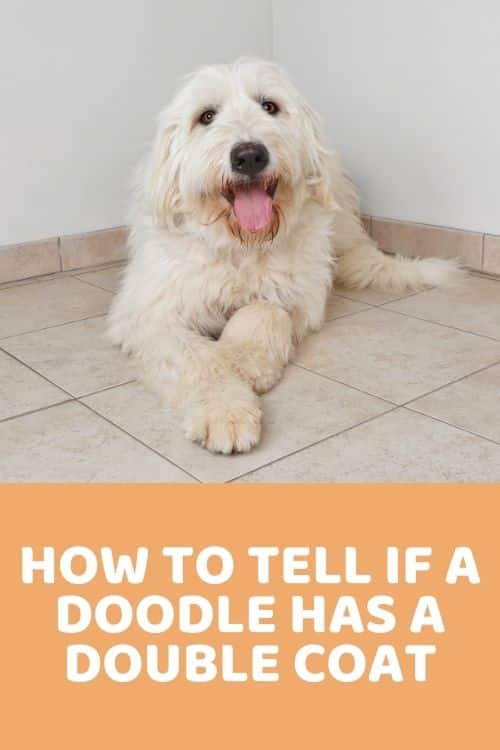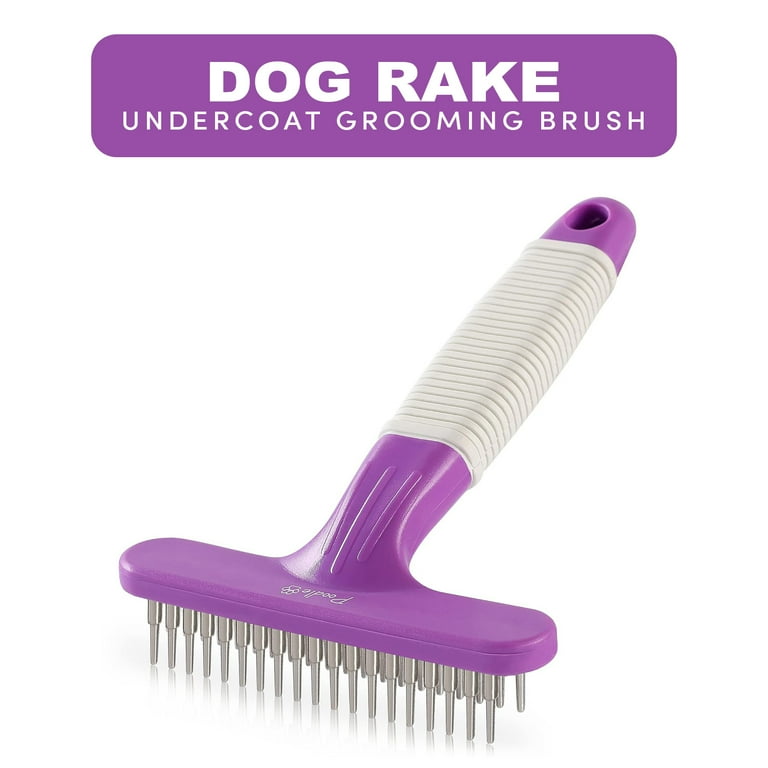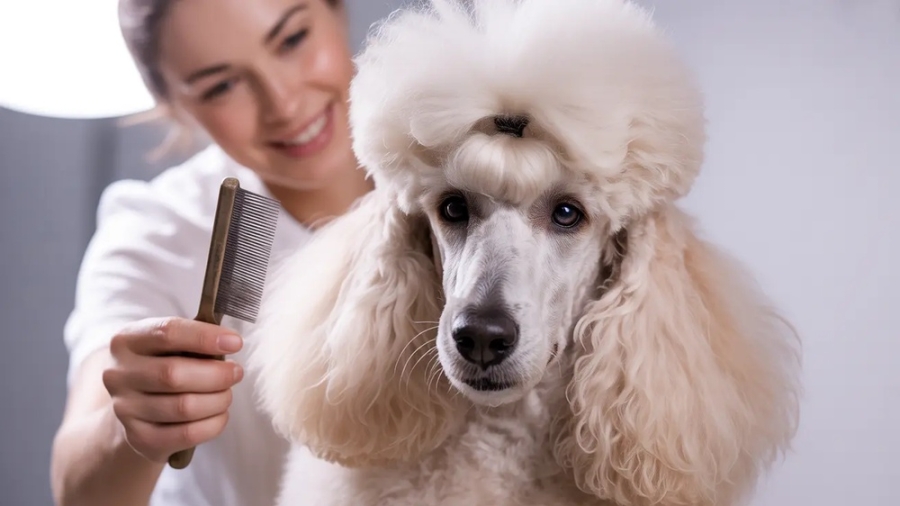If you’re wondering whether your poodle has an undercoat like many other dog breeds, you’re not alone. Understanding your poodle’s coat is key to keeping it healthy and looking great.
Unlike dogs with double coats that shed heavily and have a soft underlayer, poodles have a unique single, dense, curly coat. This means their hair grows continuously and traps loose hairs instead of shedding them all over your home. Curious about how this affects grooming and shedding?
Keep reading to discover everything you need to know about poodles and their special coats—so you can care for your furry friend the right way.
Poodle Coat Structure
Poodles have a unique coat structure that sets them apart from many other dog breeds. Their fur consists of a single layer of dense, curly hair. This single coat grows continuously and does not shed like double-coated breeds.
Unlike dogs with an undercoat, poodles do not have a soft, insulating layer beneath their outer hair. Instead, their curly hair traps loose hairs, keeping shedding minimal. This coat type helps reduce allergens and makes grooming essential.
Single Coat Composition
The poodle’s coat is made up of one layer of tightly curled hair. This single coat lacks the soft undercoat found in many other dogs. The curls create a thick, wool-like texture that holds the hair close to the skin.
The curly hair of poodles catches shed hairs instead of letting them fall. This natural trapping prevents loose hair from spreading around your home. Poodles shed very little, which is why they are often called hypoallergenic.
Poodle hair grows like human hair, without a fixed length. It requires regular trimming to keep it healthy and neat. Without grooming, their coat can become tangled and matted, causing discomfort.
Grooming Needs
Brushing a poodle’s coat removes trapped loose hairs and prevents mats. Grooming also distributes natural oils, keeping the coat soft and shiny. Regular care is important to maintain the coat’s health and appearance.
Single Vs Double Coats
Understanding the difference between single and double coats helps explain poodles’ unique fur. Many dog breeds have two layers of fur. These layers serve different purposes and affect grooming needs.
Single-coated dogs have only one layer of hair. This layer grows continuously and often has a specific texture. Double-coated dogs have two layers: an undercoat and a topcoat. Each layer plays a distinct role in protection and insulation.
What Is A Single Coat?
A single coat means one layer of hair covers the dog’s skin. Poodles have a single, dense, curly coat. Their hair grows continuously and traps shed hairs. This reduces loose fur around the home.
The single coat lacks the soft undercoat found in some breeds. Instead, it is uniform and curly. This helps keep poodles warm without extra layers.
What Is A Double Coat?
Double coats have two layers of hair. The undercoat is soft and thick. It provides insulation against cold weather.
The topcoat, or guard hairs, is longer and coarser. It protects the dog from dirt, water, and injury.
Breeds like Huskies and Golden Retrievers have double coats. These coats shed seasonally to adjust to changing weather.
How Does The Coat Type Affect Shedding?
Single-coated dogs like poodles shed less visibly. Their curls trap shed hairs inside the coat. This means less hair falls to the ground.
Double-coated dogs shed more, especially during seasonal changes. The undercoat loosens and falls out in large amounts.
Poodles need regular grooming to remove trapped hairs. This prevents matting and keeps the coat healthy.
Curly Hair And Shedding
Poodles have a unique coat that sets them apart from many other dog breeds. Their hair is curly and dense, which affects how they shed. Unlike dogs with two layers of fur, poodles only have one layer. This single coat grows continuously and traps loose hairs within the curls.
Because of this curl pattern, shed hair does not fall off easily. Instead, it stays caught in the curls until it is brushed out. This trait reduces the amount of hair that ends up on furniture or clothes. It also means poodles require regular grooming to keep their coat healthy and free of mats.
How Curly Hair Affects Shedding
Poodles’ curly hair holds onto shed hairs tightly. The curls create a natural net that traps loose strands. This prevents hair from spreading around the home. It also makes shedding less noticeable compared to straight-coated dogs. The trapped hair can build up inside the coat, which is why regular brushing is needed.
Why Poodles Need Regular Grooming
The trapped hair can cause tangles and mats if not removed. Grooming helps release shed hair and prevents knots. Brushing also stimulates the skin and distributes natural oils. This keeps the poodle’s coat shiny and soft. Grooming should be done several times a week to maintain coat health.
Difference Between Poodle Hair And Fur
Poodle hair grows continuously like human hair. It does not have a soft undercoat like fur. Fur grows to a certain length and then sheds seasonally. Poodles’ hair grows longer and requires trimming. This growth pattern contributes to their low-shedding reputation and hypoallergenic qualities.

Continuous Hair Growth
Poodles have a single, dense coat that grows continuously without an undercoat. Their curly hair traps shed strands, reducing loose fur around the home. Regular brushing helps keep their coat healthy and free of mats.
Poodles have a unique coat that grows continuously. Unlike many dog breeds, their hair does not shed in large amounts. Instead, poodle hair keeps growing like human hair. This means their fur can become quite long if not trimmed regularly.
The continuous growth helps reduce loose hair around the house. Poodles’ curly hair traps shed hair within the coat. This keeps shedding to a minimum and makes poodles popular among allergy sufferers.
Regular grooming is necessary to manage this type of coat. Brushing helps remove the trapped shed hair. It also prevents mats and tangles in the dense curls. Without grooming, the coat can become uncomfortable for the dog.
Continuous hair growth means poodles need frequent haircuts. Trimming keeps their coat healthy and neat. Owners often visit professional groomers every 4 to 6 weeks. This care routine supports the poodle’s unique hair cycle.
Grooming Needs For Poodles
Poodles have unique grooming needs due to their single, dense, curly coat. Their hair grows continuously and does not shed like many other breeds. Regular care is necessary to keep their coat healthy and free from mats. Grooming a poodle requires patience and consistency to maintain its curly texture and skin health.
Proper grooming also helps control the trapped shed hair in their curls. Without regular brushing, the hair can tangle and cause discomfort. Bathing and trimming are also important parts of their grooming routine. Understanding these needs ensures your poodle looks its best and feels comfortable.
Brushing And Detangling
Daily brushing prevents mats and tangles in a poodle’s coat. Use a slicker brush or comb designed for curly hair. Start from the skin and gently work outward. This removes loose hair trapped in curls. Brushing also spreads natural oils, keeping the coat shiny and healthy.
Bathing And Drying
Bath your poodle every three to six weeks depending on activity. Use mild dog shampoo to avoid skin irritation. After bathing, dry the coat thoroughly with a towel and a blow dryer on low heat. Drying helps prevent dampness that can lead to skin problems.
Professional Grooming And Trimming
Regular trimming keeps a poodle’s coat neat and manageable. Visit a professional groomer every six to eight weeks. Groomers shape the coat and trim around eyes, paws, and sanitary areas. Proper trimming also reduces the risk of matting and skin infections.
Hypoallergenic Traits
Poodles have a single coat of curly hair that traps shed hairs, reducing loose fur. This trait helps many people with allergies find them more comfortable around. Their coat grows continuously and needs regular brushing to stay healthy.
Hypoallergenic Traits Of Poodles
Poodles have a unique coat that makes them popular among allergy sufferers. Their coat is dense, curly, and single-layered. This means they do not have an undercoat like many other breeds.
The absence of an undercoat reduces the amount of loose hair and dander released into the environment. Poodles shed very little because their hair traps shed strands instead of letting them fall off.
This continuous hair growth requires regular grooming. Brushing removes trapped shed hair and prevents matting. It also helps control allergens by keeping the coat clean.
Single, Dense Coat
The poodle’s coat grows continuously, much like human hair. It does not have the two layers seen in double-coated dogs. This single coat produces less dander and reduces shedding.
The curls act like a net, holding shed hair close to the skin. This limits hair spread on furniture and floors, which often triggers allergies.
Reduced Shedding And Allergens
Poodles shed less than most dogs. This helps keep airborne allergens lower. Their hair also contains less dander, a common allergy cause.
People sensitive to pet allergies often tolerate poodles better. Regular grooming is key to maintaining this hypoallergenic quality.
Grooming And Maintenance
Brushing poodles at least a few times a week is important. It removes loose hair and prevents tangles. Bathing helps clear away dander and dirt.
Professional grooming every 4 to 6 weeks keeps the coat healthy. This routine supports the coat’s hypoallergenic properties and keeps your home cleaner.
Water Resistance Of Curly Coats
Poodles have a unique coat that stands out for its curls. These curls do more than give poodles their charming look. They also help protect the dog from water. The water resistance of curly coats is a key feature for poodles, especially since many enjoy swimming.
The tight curls create a barrier against moisture. Water tends to slide off rather than soak in. This keeps the skin underneath dry and comfortable. While poodles do not have an undercoat like many other breeds, their curly coat still offers excellent water resistance.
How Curly Hair Repels Water
Curly hair forms small loops that trap air. This air acts like a shield against water. Water droplets cannot easily penetrate the curls. Instead, they bead up and roll away. The curls help keep the coat light, even when wet. This natural water resistance helps poodles stay warm and dry.
Benefits Of Water Resistance For Poodles
Water resistance is especially useful for active poodles. They often enjoy swimming or playing in wet grass. The coat’s resistance reduces the chance of skin irritation. It also prevents the dog from becoming too cold after getting wet. This feature supports the poodle’s history as a water retriever.
Care Tips To Maintain Water Resistance
Regular grooming is key to keeping the coat water-resistant. Brushing removes dirt and prevents mats. Mats can trap moisture, reducing the coat’s natural protection. Bathing with gentle shampoo helps keep curls clean without stripping oils. Drying the coat thoroughly after water exposure preserves its barrier function.

Thermoregulation Benefits
Poodles lack an undercoat, so their single curly coat helps regulate body temperature by trapping air close to the skin. This unique coat keeps them warm in cold weather and cool in heat. Regular grooming supports their natural thermoregulation by maintaining coat health.
Poodles have a unique coat that helps regulate their body temperature. Their dense, curly hair acts as a natural barrier against weather changes. This helps them stay comfortable in both cold and warm conditions.
The tight curls trap air close to the skin. This air layer provides insulation, keeping the dog warm in chilly weather. At the same time, it prevents overheating by allowing some airflow.
Insulation In Cold Weather
Even without an undercoat, poodles stay warm in cold temperatures. Their thick curls hold heat near the skin. This natural insulation protects them from cold winds and low temperatures.
The coat’s structure reduces heat loss and keeps energy conserved. Poodles can enjoy outdoor activities without feeling too cold.
Cooling In Warm Weather
The poodle’s coat also helps in hot weather. The curls create small air pockets that allow air to circulate. This airflow cools the skin and reduces heat buildup.
Regular grooming helps maintain this airflow. Removing mats and tangles lets the coat breathe better, aiding in temperature control.
Protection From Sun And Elements
The dense hair shields poodles from harmful sun rays. It also protects their skin from dirt, moisture, and insects. This layer acts as a natural defense against environmental stress.
Proper coat care keeps this protection strong and effective. It helps poodles stay healthy and comfortable in many weather conditions.
Differentiating Poodles From Doodles
Understanding the differences between Poodles and Doodles is important for pet owners and enthusiasts. Both breeds share some traits but differ significantly in coat type and care needs. These differences affect shedding, grooming, and allergy concerns. Clear knowledge helps in making better choices for homes and lifestyles.
Coat Structure Differences
Poodles have a single, dense, curly coat. This coat grows continuously without an undercoat. Doodles, a mix of Poodles with other breeds, usually have a double coat. Their coat includes a soft undercoat and a topcoat. This undercoat sheds seasonally, unlike Poodles’ single coat.
Shedding Patterns
Poodles shed very little because their curls trap loose hair. Their coat holds shed hairs until brushing removes them. Doodles shed more due to their undercoat. The undercoat loosens hair in spring and fall. Owners may notice more loose hair with Doodles.
Grooming Needs
Poodles require regular brushing to prevent mats in their curly coat. Their hair grows nonstop and needs trimming. Doodles need grooming for both layers of their coat. The undercoat requires special attention during shedding seasons. Proper grooming reduces tangles and keeps the coat healthy.

Frequently Asked Questions
Do Poodles Have An Undercoat?
No, poodles do not have an undercoat. They have a single, dense, curly coat that traps shed hair, reducing shedding. Their hair grows continuously and requires regular grooming to prevent mats and tangles. This single coat contributes to their hypoallergenic qualities.
Are Poodles Double Coated?
No, poodles are not double coated. They have a single, dense, curly coat that grows continuously and sheds minimally.
Do Poodles Need To Be Deshedded?
Poodles do not need deshedding like double-coated breeds. Their curly, single coat traps loose hair, requiring regular brushing to prevent mats and remove trapped shed hair.
What Happens If You Never Cut A Poodle’s Hair?
Neglecting to cut a poodle’s hair causes severe matting, skin irritation, and discomfort. Their coat grows continuously and traps dirt. Regular trimming prevents health issues and maintains a clean, manageable coat.
Conclusion
Poodles do not have an undercoat. Their single, curly coat grows continuously. This unique coat traps shed hair, reducing loose fur around the home. Regular brushing is key to keep their coat healthy and free of mats. Understanding this helps owners provide proper care.
Poodles’ coat needs differ from double-coated breeds. Knowing these facts ensures better grooming and comfort for your poodle.

